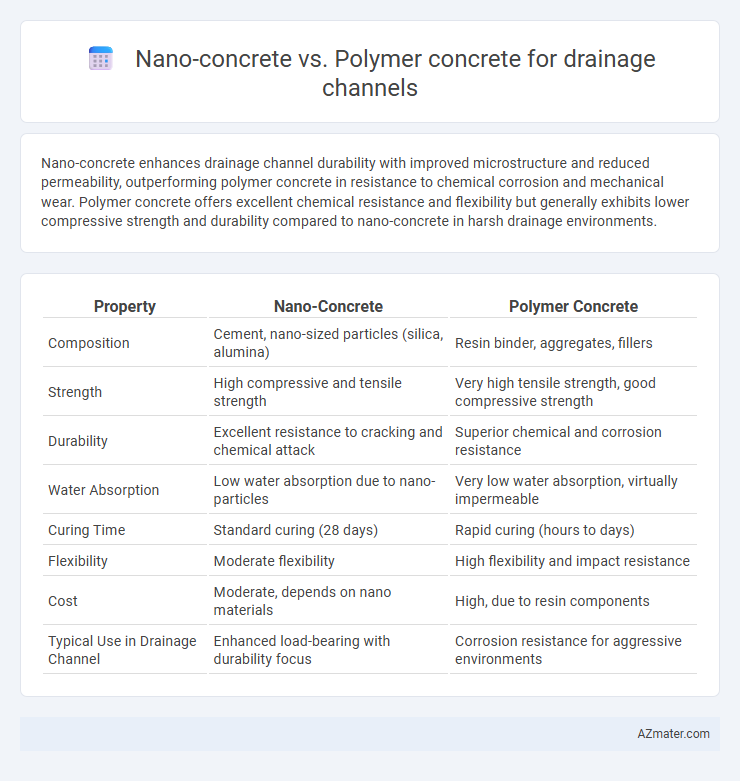Nano-concrete enhances drainage channel durability with improved microstructure and reduced permeability, outperforming polymer concrete in resistance to chemical corrosion and mechanical wear. Polymer concrete offers excellent chemical resistance and flexibility but generally exhibits lower compressive strength and durability compared to nano-concrete in harsh drainage environments.
Table of Comparison
| Property | Nano-Concrete | Polymer Concrete |
|---|---|---|
| Composition | Cement, nano-sized particles (silica, alumina) | Resin binder, aggregates, fillers |
| Strength | High compressive and tensile strength | Very high tensile strength, good compressive strength |
| Durability | Excellent resistance to cracking and chemical attack | Superior chemical and corrosion resistance |
| Water Absorption | Low water absorption due to nano-particles | Very low water absorption, virtually impermeable |
| Curing Time | Standard curing (28 days) | Rapid curing (hours to days) |
| Flexibility | Moderate flexibility | High flexibility and impact resistance |
| Cost | Moderate, depends on nano materials | High, due to resin components |
| Typical Use in Drainage Channel | Enhanced load-bearing with durability focus | Corrosion resistance for aggressive environments |
Introduction to Advanced Concrete Technologies
Nano-concrete incorporates nanoparticles to enhance mechanical strength, durability, and resistance to environmental factors, making it highly suitable for drainage channels exposed to harsh conditions. Polymer concrete uses synthetic resins as binders, offering superior chemical resistance and rapid curing time, ideal for applications requiring corrosion resistance and quick installation. Both materials represent advanced concrete technologies that improve performance and longevity of drainage infrastructure beyond conventional concrete.
Understanding Nano-Concrete: Composition and Properties
Nano-concrete incorporates nanoparticles such as nanosilica or nanoalumina, enhancing its microstructure by filling pores and refining cement hydration products, which significantly increases strength and durability. Its improved density and reduced permeability make it highly resistant to water infiltration, chemical attack, and abrasion, critical factors for drainage channel applications. Compared to polymer concrete, nano-concrete offers superior mechanical properties and long-term performance under harsh environmental conditions due to its nano-engineered composition.
Polymer Concrete Defined: Key Components and Characteristics
Polymer concrete for drainage channels consists primarily of aggregates bound together by a polymer resin, such as epoxy, polyester, or vinyl ester, which enhances chemical resistance and mechanical strength. Its key characteristics include high durability, low permeability, and superior resistance to corrosion and abrasion compared to traditional cement-based materials. The use of polymer concrete ensures extended service life and reduced maintenance costs in aggressive environments where drainage systems are exposed to chemicals and harsh weather conditions.
Durability and Longevity Comparison
Nano-concrete exhibits superior durability in drainage channels due to its refined nanoparticle structure that enhances strength and reduces permeability, leading to improved resistance against chemical attacks and abrasion. Polymer concrete offers excellent chemical resistance and flexibility, which contributes to longevity in corrosive environments but may be less effective against mechanical stress compared to nano-concrete. For drainage applications, nano-concrete's enhanced microstructure typically results in longer service life and lower maintenance requirements than polymer concrete.
Chemical Resistance in Harsh Drainage Environments
Nano-concrete exhibits superior chemical resistance compared to polymer concrete when used in drainage channels exposed to harsh environments, due to its nano-scale additives that enhance durability against acidic and alkaline substances. Polymer concrete offers good resistance but may degrade faster under continuous exposure to aggressive chemicals such as sulfates and chlorides commonly found in industrial drainage systems. The enhanced chemical stability of nano-concrete extends the lifespan of drainage infrastructure by minimizing surface erosion and preventing structural weakening in corrosive conditions.
Mechanical Strength: Load-Bearing Capabilities
Nano-concrete exhibits superior mechanical strength and load-bearing capacity compared to polymer concrete, making it more suitable for heavy-duty drainage channels subjected to high traffic loads. The incorporation of nanoparticles enhances the microstructure density and reduces micro-cracks, resulting in improved compressive and flexural strength. Polymer concrete offers good chemical resistance but generally demonstrates lower load tolerance and mechanical durability under heavy dynamic stresses.
Installation Process: Ease and Speed for Drainage Channels
Nano-concrete offers rapid curing times and lightweight handling, enabling faster installation of drainage channels compared to traditional materials. Polymer concrete provides excellent adhesion and flexibility, simplifying placement in complex channel geometries and reducing labor efforts. Both materials significantly enhance installation efficiency, with nano-concrete excelling in speed and polymer concrete optimizing ease in intricate designs.
Cost Analysis: Nano-Concrete vs Polymer Concrete
Nano-concrete offers a cost advantage over polymer concrete in drainage channel applications due to its lower raw material expenses and reduced need for specialized additives. The manufacturing process of nano-concrete typically consumes less energy, contributing to overall cost savings compared to the polymer-based composite, which involves expensive resin binders and longer curing times. Maintenance costs also favor nano-concrete as its superior crack resistance minimizes repair frequency and associated labor expenses.
Environmental Impact and Sustainability
Nano-concrete for drainage channels offers enhanced durability and reduced material usage, leading to lower carbon emissions and longer service life compared to traditional materials. Polymer concrete, although resistant to chemicals and water, relies on synthetic resins derived from non-renewable petrochemicals, raising concerns about its environmental footprint and recyclability. Sustainable drainage solutions favor nano-concrete due to its potential for reduced ecological impact and improved lifecycle performance.
Best Applications and Recommendations for Drainage Systems
Nano-concrete offers superior compressive strength and durability, making it ideal for heavy-load drainage channels exposed to high traffic or industrial use. Polymer concrete provides excellent chemical resistance and faster curing times, which is best suited for drainage systems handling aggressive wastewater or corrosive environments. For optimal drainage system performance, use nano-concrete in structural components requiring long-term resilience and polymer concrete in areas demanding rapid installation and chemical resistance.

Infographic: Nano-concrete vs Polymer concrete for Drainage channel
 azmater.com
azmater.com